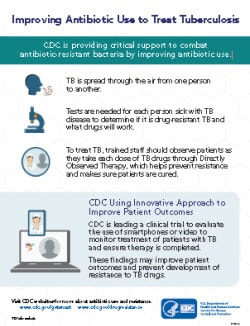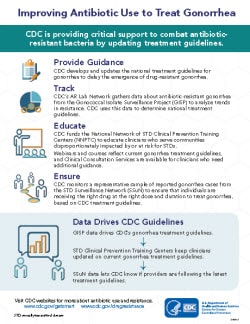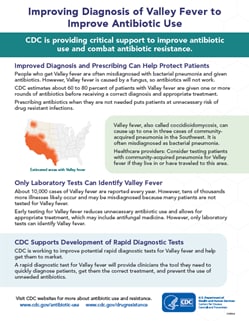Improving Antibiotic Use for Tuberculosis (TB), Gonorrhea, and Valley Fever
CDC provides critical support to combat antibiotic resistance by improving antibiotic use in community settings for infectious diseases like tuberculosis (TB), gonorrhea, and Valley fever.
Improving Antibiotic Use to Treat TB

Text is available in a TB printable factsheet with graphics pdf icon[PDF – 1 page]
TB is spread through the air from one person to another. Tests are needed for each person sick with TB disease to determine if it is drug-resistant TB and what drugs will work. To treat TB, trained staff should observe patients as they take each dose of TB drugs through Directly Observed Therapy, which helps prevent resistance and makes sure patients are cured.
CDC Using Innovative Approach to Improve Patient Outcomes
CDC is leading a clinical trial to evaluate the use of smartphones or video to monitor treatment of patients with TB and ensure therapy is completed. These findings may improve patient outcomes and prevent development of resistance to TB drugs.
Improving Antibiotic Use to Treat Gonorrhea

Text is available in a Gonorrhea printable factsheet with graphics pdf icon[PDF – 1 page]
Provide Guidance
CDC develops and updates the national treatment guidelines for gonorrhea to delay the emergence of drug-resistant gonorrhea.
Track
CDC’s Antibiotic Resistance Laboratory Network gathers data about antibiotic-resistant gonorrhea from the Gonococcal Isolate Surveillance Project (GISP) to analyze trends in resistance. CDC uses these data to determine national treatment guidelines.
Educate
CDC funds the National Network of Sexually Transmitted Disease (STD) Clinical Prevention Training Centers (NNPTC) to educate clinicians who serve communities disproportionately impacted by or at risk for STDs. Webinars and courses reflect current gonorrhea treatment guidelines, and Clinical Consultation Services are available for clinicians who need additional guidance.
Ensure
CDC monitors a representative sample of reported gonorrhea cases from the STD Surveillance Network (SSuN) to ensure that individuals are receiving the right drug at the right dose and duration to treat gonorrhea, based on CDC treatment guidelines.
Data Drives CDC Guidelines
- GISP data drives CDC’s gonorrhea treatment guidelines.
- STD Clinical Prevention Training Centers keep clinicians updated on current gonorrhea treatment guidelines.
- SSuN data lets CDC know if providers are following the latest treatment guidelines.
Improving Diagnosis of Valley Fever to Improve Antibiotic Use

Text is available in a Valley Fever printable factsheet with graphics pdf icon[PDF – 1 page]
Improved Diagnosis and Prescribing Can Help Protect Patients
People who get Valley fever are often misdiagnosed with bacterial pneumonia and given antibiotics. However, Valley fever is caused by a fungus, so antibiotics will not work. CDC estimates about 60% to 80% of patients with Valley fever are given one or more rounds of antibiotics before receiving a correct diagnosis and appropriate treatment. Prescribing antibiotics when they are not needed puts patients at unnecessary risk of drug-resistant infections.
Valley fever, also called coccidioidomycosis, can cause up to one in three cases of community-acquired pneumonia in the Southwest. It is often misdiagnosed as bacterial pneumonia.
Healthcare professionals: Consider testing patients with community-acquired pneumonia for Valley fever if they live in or have traveled to this area.
Only Laboratory Tests Can Identify Valley Fever
About 10,000 cases of Valley fever are reported every year. However, tens of thousands more illnesses likely occur and may be misdiagnosed because many patients are not tested for Valley fever. Early testing for Valley fever reduces unnecessary antibiotic use and allows for appropriate treatment, which may include antifungal medicine. However, only laboratory tests can identify Valley fever.
CDC Supports Development of Rapid Diagnostic Tests
CDC is working to improve potential rapid diagnostic tests for Valley fever and help get them to market. A rapid diagnostic test for Valley fever will provide clinicians the tool they need to quickly diagnose patients, get them the correct treatment, and prevent the use of unneeded antibiotics.